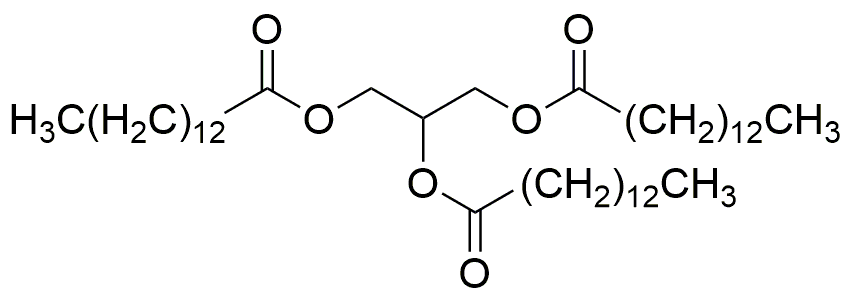Trimyristin is widely utilized in research focused on:
- Food Industry: It serves as a fat source in food formulations, enhancing texture and mouthfeel in products like margarine and baked goods.
- Pharmaceuticals: Used as an excipient in drug formulations, it aids in the delivery of active ingredients, improving bioavailability and stability.
- Cosmetics: Commonly found in creams and lotions, it acts as an emollient, providing moisturizing properties and a smooth application.
- Biotechnology: Employed in the preparation of liposomes for drug delivery systems, facilitating targeted therapy in various medical applications.
- Research Applications: Utilized in studies related to lipid metabolism and energy storage, helping researchers understand fat digestion and absorption mechanisms.
General Information
Properties
Safety and Regulations
Applications
Trimyristin is widely utilized in research focused on:
- Food Industry: It serves as a fat source in food formulations, enhancing texture and mouthfeel in products like margarine and baked goods.
- Pharmaceuticals: Used as an excipient in drug formulations, it aids in the delivery of active ingredients, improving bioavailability and stability.
- Cosmetics: Commonly found in creams and lotions, it acts as an emollient, providing moisturizing properties and a smooth application.
- Biotechnology: Employed in the preparation of liposomes for drug delivery systems, facilitating targeted therapy in various medical applications.
- Research Applications: Utilized in studies related to lipid metabolism and energy storage, helping researchers understand fat digestion and absorption mechanisms.
Documents
Safety Data Sheets (SDS)
The SDS provides comprehensive safety information on handling, storage, and disposal of the product.
Product Specification (PS)
The PS provides a comprehensive breakdown of the product’s properties, including chemical composition, physical state, purity, and storage requirements. It also details acceptable quality ranges and the product's intended applications.
Certificates of Analysis (COA)
Search for Certificates of Analysis (COA) by entering the products Lot Number. Lot and Batch Numbers can be found on a product’s label following the words ‘Lot’ or ‘Batch’.
*Catalog Number
*Lot Number
Certificates Of Origin (COO)
This COO confirms the country where the product was manufactured, and also details the materials and components used in it and whether it is derived from natural, synthetic, or other specific sources. This certificate may be required for customs, trade, and regulatory compliance.
*Catalog Number
*Lot Number
Safety Data Sheets (SDS)
The SDS provides comprehensive safety information on handling, storage, and disposal of the product.
DownloadProduct Specification (PS)
The PS provides a comprehensive breakdown of the product’s properties, including chemical composition, physical state, purity, and storage requirements. It also details acceptable quality ranges and the product's intended applications.
DownloadCertificates of Analysis (COA)
Search for Certificates of Analysis (COA) by entering the products Lot Number. Lot and Batch Numbers can be found on a product’s label following the words ‘Lot’ or ‘Batch’.
*Catalog Number
*Lot Number
Certificates Of Origin (COO)
This COO confirms the country where the product was manufactured, and also details the materials and components used in it and whether it is derived from natural, synthetic, or other specific sources. This certificate may be required for customs, trade, and regulatory compliance.

